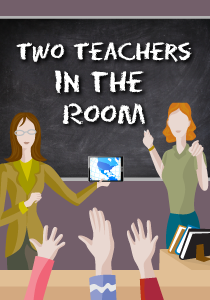Co-Teaching Without Boxes or Boundaries
A MiddleWeb Blog

After hearing this statement a number of times over the last few weeks, it made me think about what we are actually saying when we use this fairly clichéd expression.
Of course thinking and learning are contextual – and there are times when thinking inside the box may be appropriate. But overall, thinking out of the box has gained momentum as a valued way of creating solutions.

Before you read on, take a moment and guide yourself to think about finding solutions through a fresh perspective. Check out this nine dots puzzle to exercise out-of-the-box thinking skills. Are you feeling the excitement of creating solutions and expanding your ability to think divergently?
Out of the Box Co-Thinking
The opportunity for two teachers to combine their thinking when making instructional decisions can result in some incredibly powerful learning experiences for students.
In fact I’m thinking when two teachers are in the room and in-synch, there’s no need for in-box or out-of-box thinking. It can become an experience where there is no need for a box at all! We are talking a barrier-free co-teaching experience! What would that look like? Here’s some of my thinking.
No Boundaries Co-Teaching
For every apparent limitation or frustrating scenario in a co-teaching relationship, there can be a solution. Here are my top three thoughts for today.
- Be free to express EACH co-teacher’s expertise.

- Make co-planning happen – No matter what!
All too often, teachers just do not have a specified co-planning time in their official schedules. So the question becomes, what are you going to DO about it? Sure, complaining about it might provide some temporary relief. But if no change is forthcoming from on-high, you’ll often find yourself slipping into a negative venting cycle.
So why not be more productive? Use that same energy to seek solutions. For starters, replace the absence of official planning time with consistent communication strategies that create ongoing, informed understandings between both teachers.
Create a log: open up a shared Google Doc (a tabular format works) where each day’s big lesson ideas are tracked and expressed. In addition, delineate a role for each co-teacher on each day. Decide on which co-teaching model will best serve for the context of each lesson. This takes the mystery out of working together each day.
Use post-it communications: Each co-teacher could jot how the lesson went from their perspective and pass the post-its to one another as they rush off to their next class. This takes no time at all. It is naturally embedded within the context of class time and can guide each to plan ahead for the next day.
Email: Let’s not lose sight of good old-fashioned email! It can serve as timely feedback in a feed-forward kind of way to reflect and proactively plan ahead.
- Be Resilient!
Strive to focus on the positive aspects of what you and your co-teacher bring to your co-teaching experience. We all know of positive, negative, and indifferent co-teaching narratives. Move beyond the negative tangling of thoughts that could lead to frustration. Find at least one thing to hold on to – and find a way to apply divergent thinking – to make the relationship work within the classroom.
Divergent thinking typically occurs in a spontaneous, free-flowing, ‘non-linear’ manner, such that many ideas are generated in an emergent cognitive fashion.” Source
Assert yourself. Respect and accept your co-teacher’s practices. Facilitate a blending of the best that you both have to offer.

If you’re looking for more thoughts on what it takes to achieve co-teaching success, check out and sign in for this archived Education Week webinar: Ten Tips for Co-Teaching Success where I share more details for co-teaching success.
Make it your mission to forget about the box and co-create barrier-free co-teaching experiences this year.
What are you finding to be the most positive – or the most frustrating – of your current co-teaching experiences? Share your voice here. Let’s not just think out of the box together – let’s remove it completely!


































Dear Elizabeth (and All), Thank you for your post. School librarians can serve as effective coteachers for special education and classroom teachers and specialists. Your post connected with an Animoto video I made a few years ago to show classroom-library coteaching. Check it out: http://tinyurl.com/jmcoteachvideo
Thank you, Judi, for sharing this jazzy, inspirational visual/auditory representation of taking risks–making it work–and removing any co-teaching boxes!
Yes, agreed! The librarians in my district serve as AMAZING resources and teaching partners for everyone. So wise and rewarding to take the stance that co-teachers and librarians unite around our co-teaching world! (I do believe I feel a future blog post emerging here!) Co-teaching involves collaboration with all colleagues–bringing our collective voices together to co-create–for and with our students. Thanks so much for sharing!